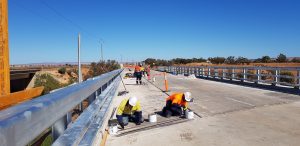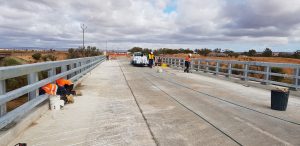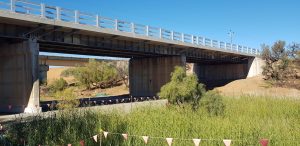Carbon Fibre Reinforced Polymer Bars In Bridge Widening

What is it?
Fibre reinforced polymer is a material comprised of high strength continuous fibres, such as glass, carbon, or steel wires which are embedded into a polymer matrix. In this instance, carbon was used as the main reinforcing element while the polymer matrix acted as the binder that protects the fibres and helps to transfer the loads to and between the fibres.
Carbon is generally used far more than glass alternatives as it has superior mechanical properties, such as higher tensile strength, stiffness, and durability. This makes the structure incredibly strong and able to take increased loads that it otherwise would not be able to handle if the reinforcement were not used.
While it can come in a variety of shapes and sizes, for this project they were created as rods as they would be used to help bind and strengthen an existing concrete and the newly formed widened section of the bridge.

Why CFRP?
CFRP is commonly used in many concrete structures to increase the strength of the structure. As the project was widening a concrete bridge that commonly has heavy semi-trailers drive over, they were implemented to ensure the bridge would be able to hold extra weight, while simultaneously ensuring that the old concrete and the newly added concrete of the bridge would be able to fuse together more cohesively. The rods provide additional tension reinforcement which in turn increases the flexural strength of the concrete bridge, allowing larger loads.

How was it installed?
A portion of the rods were placed in the old concrete, while the remaining portion was embedded in the new addition to the bridge. This helped strengthen both parts of the structure, while ensuring they were now strongly attached to each other. For this project, deep grooves, approximately 18mm deep and 400mm apart were cut into the bridge so that the rods could be placed horizontally along the bridge so that each one was partly in the existing concrete and the new concrete of the bridge. The 3.5m long rods were then placed inside and Master Brace 4000 was used as the binder over the top of the rods to ensure the rods were secured into both the new and existing concrete.

How was it tested for strength?
It is critical that the bond between the Fibre Reinforced Polymer and the existing concrete is tested to ensure that the rods can withstand necessary loading. The rods has to pass an adhesion test that composed of 6 trials. A hole about 50mm wide and 20mm deep was cored and tested using the latest technology. Each trial had to have a minimum of 1.35MPa in strength and a mean for the 6 tests had to be a minimum of 1.5MPa to ensure strength suitability.
To keep up to date with our Epic projects, follow us on Instagram or Facebook!
